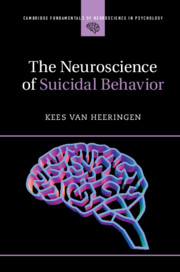Book contents
- Frontmatter
- Dedication
- Contents
- Figures
- Tables
- Preface
- Chapter One What Is Suicidal Behavior, and Can It Be Prevented?
- Chapter Two Stress, Vulnerability, and Suicide
- Chapter Three The Dark Side of the Brain
- Chapter Four Lethal Signals
- Chapter Five I Think, Therefore I Do Not Want to Be
- Chapter Six Images of the Suicidal Brain
- Chapter Seven “In my end is my beginning”
- Chapter Eight I Predict, Therefore I Cannot Be
- Chapter Nine Predicting the Unpredictable
- Chapter Ten The Treatment of Suicide Risk
- Glossary
- References
- Index
- Colour Plates
Chapter Eight - I Predict, Therefore I Cannot Be
A Predictive Coding Account of Suicidal Behavior
Published online by Cambridge University Press: 22 May 2019
- Frontmatter
- Dedication
- Contents
- Figures
- Tables
- Preface
- Chapter One What Is Suicidal Behavior, and Can It Be Prevented?
- Chapter Two Stress, Vulnerability, and Suicide
- Chapter Three The Dark Side of the Brain
- Chapter Four Lethal Signals
- Chapter Five I Think, Therefore I Do Not Want to Be
- Chapter Six Images of the Suicidal Brain
- Chapter Seven “In my end is my beginning”
- Chapter Eight I Predict, Therefore I Cannot Be
- Chapter Nine Predicting the Unpredictable
- Chapter Ten The Treatment of Suicide Risk
- Glossary
- References
- Index
- Colour Plates
Summary
Computational neuroscience uses formal models of brain function to characterize the mechanisms behind behavioral problems. The production of false beliefs and their behavioral consequences are a central issue in such models. Hopelessness and suicidal thoughts are examples of such false beliefs that commonly lead to suicidal behavior as a consequence. In normal everyday life, people update their beliefs based on what they perceive: bottom-up sensory inputs are compared with top-down beliefs, and mismatches are signaled as prediction errors. Neurobiological correlates of belief updating are increasingly demonstrated. Cortical activations as demonstrated in functional neuroimaging studies, such as those reported in Chapter 6, thus reflect the production of prediction errors that signal a mismatch between beliefs and perceptual information. These errors can be minimized in several ways: beliefs can be updated, or sensory input can be minimized by withdrawal into oneself or escape from this world. If something goes wrong in this process of belief updating, false beliefs may develop and persist despite perceptual proof of the opposite. This chapter will describe a predictive coding model of suicidal behavior, in which findings from neurocognitive, neuroimaging, and neurobiological studies can be integrated. This model leads to a new understanding of suicide and, consequently, to new approaches to prevention.
Keywords
Information
- Type
- Chapter
- Information
- The Neuroscience of Suicidal Behavior , pp. 146 - 164Publisher: Cambridge University PressPrint publication year: 2018
